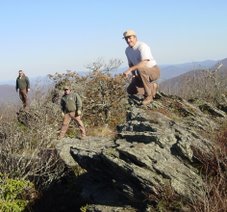
This created a 25 foot high waterfall, which over time, eroded the ground beneath it until culvert sections were left unsupported. One culvert section broke off and the process started over again at the next section of 20' culvert, until the resulting erosion shown in the photo's below threatened the stability of the road.


We came up with a fix for this area with the advice of an engineer from our Engineering Division who came out one day to observe our work. Our first task was to remove two of the extended culvert sections. The one that had broken off was pulled from the gully with the dozer winch, the next one was excavated with the backhoe.


Next, we needed to convert the very steep banks of the "cut and fill" used to create the road in this section into a better designed drainage area. The easiest way to do this was to shove soil straight down the embankment with the dozer. After careful assesment of the risks involved, Jim strapped into the dozer and shoved down the steep embankment using the mound of soil that he was pushing as his emergency brake. At this grade, the dozer just kind of slides downhill on a one way trip, a path was pushed beforehand as a way to climb back out.

The drainage basin continues to take shape, the spillway is lined, and rip rap is placed...


Some matting is placed on the steeper sections.

We lined most of the waterway with heavy fabric, installed a few log check damns, hand placed several tons of rip rap, and a large pile of brush in the bottom of the basin to help stabilize the soil and slow down any heavy water flows. We then seeded the entire area down with a mixture of grasses and crown vetch.

Finally, we mulch down the site with straw. We completed this project in less than a week.







